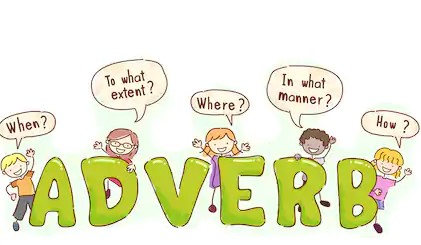
ADVERB
What are adverbs? Words that are used to qualify a verb, adjective, conjunction, preposition. An adverb is always placed adjacent to the word that it modifies, it enhances the meanings and tasks of the verb. If the position of adverb is changed the meaning of the sentence will be changed.
“An adverb in a sentence is like an icing to a cake and what cheese to a pizza.”
Adverbs are similar to adjectives in the way they describe things. But the difference is that an adjective describes a noun, for example – a green dress, a tall man, a late supper, my six sons, on the other hand, an adverb doesn’t tell anything about the noun.
It describes something about the verb, how the verb acts. It adds qualitative detail to the verb in a sentence, it0 gives more information or modifies the meaning of the verb. The verb may “act” quickly, routinely, romantically or whatever way you can appropriately imagine. Example – She sings Gracefully. Choosing the correct order of adverbs can be difficult, but the more you practice, the easier it becomes! Let us now understand the different types of Adverbs.
A lot of adverbs usually ends with “–ly” at the end but not always.
Don’t Miss: Best English Grammar Notes for School/College Students
Types Of Adverbs in English Grammar
There are 6 types of adverbs. We will discuss each type of adverb one by one. To explain in a better way, we have provided examples and sentences after each type. Here you go:–
- Adverbs Of Time – It describes when or for how long something happened. Adverbs can be placed at any position.
List Of Adverbs – Now, yesterday, soon, later, after, before, yet, tomorrow, already, tonight, today, then, last month, last year, etc.
Example –
- I’ve been here before.(end position)
- Tomorrow I’m going to paris.(front position)
- Alex will be here soon.(end position)
- We’ve already told you.(middle position)
- Yesterday she came to visit me.
- Adverbs Of Frequency – Adverb of frequency tells us the frequency with which a certain action has taken place. It can placed at any position front, mid or end position.
List of adverbs – Always, something, usually, often, frequently, rarely, hardly, never, generally etc.
Important note: adverbs of frequency such as “never”, “often”, “sometimes” and “always” go directly after the subject.
Example –
- She usually comes late.(mid position)
- We rarely go to movie.(mid position)
- She normally eats three meals a day.(mid position)
- sometimes I see him at the school.(front position)
- She visits me occasionally.(end position)
- He never gets late for his work.
- Rakesh always comes first in his class.
- He hardly pays attention in his lectures.
Types of Adverbs: Video
- Adverb Of Place – Adverb of place describes the place where the actions took place. These verbs can be placed at the front, middle or at the end of the sentence.
List of Adverbs – Everywhere, near, off, above, far, on, abroad, away, back, here, out, outside, behind, in, down, downstairs, backward etc.
Also Read: Tenses in English Grammar with Rules and Examples
Example –
- Is that your cap there?(end position)
- He is standing outside.(end position)
- I can’t find her anywhere.(end position)
- Next to her I felt like a fraud.(front position)
- Stay away from the fire.(middle position)
- Adverbs Of Manner – Adverb of manner tell us in what way or in what manner the action takes place. It describes how something happens. In which manner the work is being done.
List of adverbs – Beautifully, calmly, cheerfully, carefully, patiently, perfectly, slowly, badly, painfully, well, efficiently, quickly, loudly etc.
Example –
- She always smiles sweetly.
- He was listening patiently.
- I’m perfectly fine.
- She was injured badly.
- She managed the tense situation so easily.
- Anna sang gracefully.
- She laughed loudly.
- Adverbs Of Degree – It shows the manner or degree upto which an action took place. Some of the examples of these adverbs are given below:-
Names of adverbs – Quite, too, entirely, extremely, very, rather, almost, just, barely, deeply etc.
Examples –
- He was quite agreeable to accepting the plan.
- I’m absolutely sure about it.
- It was extremely high.
- He is too lazy in his work.
- I’m almost done with my homework.
- He analyzed the situation deeply.
6. Adverbs Of Affirmation And Negation – It tells about the statement which is true, equivalent or negative.
List of adverbs – Surely, obviously, absolutely, apparently, undoubtedly, certainly.
Example –
- Honestly, I wouldn’t suggest you to attend the party.
- It clearly shows the better results after all the planning she did.
- She is undoubtedly the most beautiful girl in her family.
- We’re obviously going to need some help.
- You’re absolutely right.
Let us try to explain to you the difference between a good adverb and a bad adverb, consider these two sentences: “He lived his life happily ever after” and “She lived her life sadly”. Which one seems the best? The first sentence seems perfect because it conveys that the subject or doer passed his life happily. On the other hand, “sadly” changes the whole meaning of sentence.
So, this was all about the Adverbs and their types. Hope you found the article useful. If you have any queries, feel free to ask us through the comments section below. Stay Tuned with Careeradvice4u.com
- Adverbs and Their Examples, Sentences [ English Grammar Online ] - June 11, 2019

Leave a Reply